Capturing life’s fastest moments requires more than an ordinary camera, whether it’s the flap of a hummingbird’s wings, the burst of a balloon, or the impact of a single water droplet.
High speed cameras are designed to record thousands of frames per second, delivering stunning slow-motion footage that’s both visually striking and scientifically valuable. From filmmakers and sports coaches to engineers and researchers, these cameras unlock new perspectives that standard devices can’t achieve.
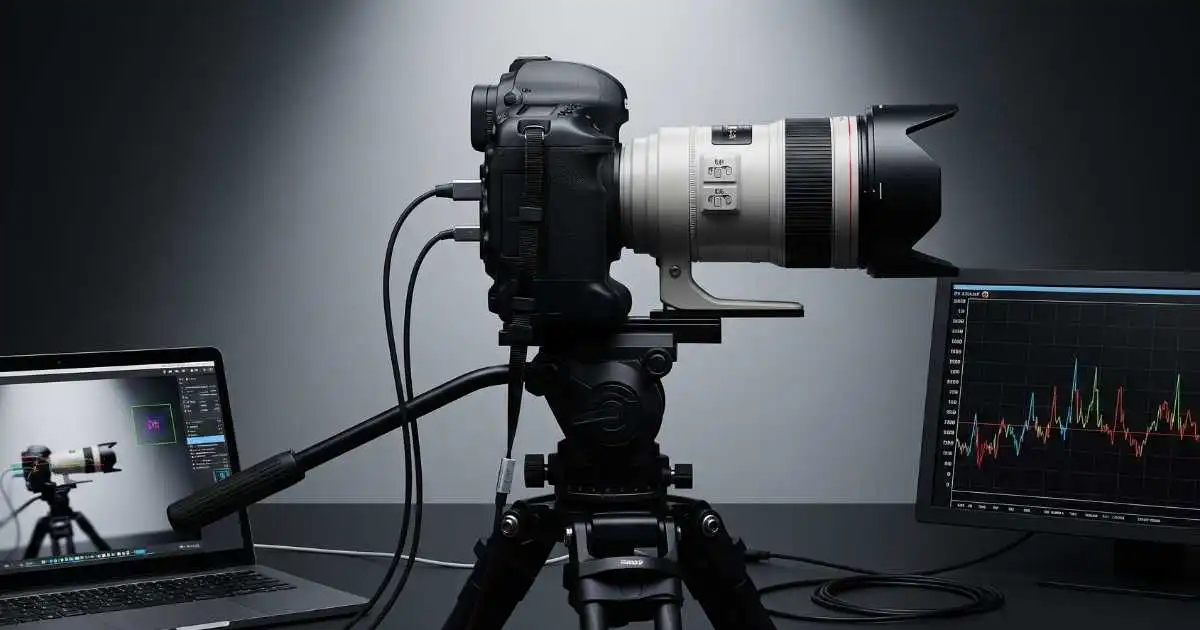
With so many models available from compact action cams to advanced cinema and research-grade equipment, choosing the Best high speed camera can feel overwhelming. This guide will break down the key features, performance factors, and top picks to help you find the perfect fit for your needs.
Quick Navigation & Previews
- Best High Speed Camera in 2025
- Comparison Table of Top 10 High-Speed Cameras
- What to Look for When Buying a High-Speed Camera
- Our 10 Picks of the Best High Speed Cameras
- 1. Sony Alpha 9 III
- 2. Canon EOS R5 Mark II Body
- 3. Nikon Z 9
- 4. Fujifilm X-H2S
- 5. Panasonic LUMIX GH6
- 6. Blackmagic Design URSA Mini Pro 12K
- 7. GoPro HERO13 Black
- 8. Sony Alpha 1 Full-frame Interchangeable Lens Mirrorless Camera
- 9. Nikon Z6 III | Full-Frame mirrorless Still & Video Camera
- 10. DJI Osmo Action 5 Pro Standard Combo
- Things to Consider When Buying Best High Speed Camera
- Buying Guide: Choosing Your High-Speed Camera
- Frequently Asked Questions
- What is the main difference between a “high-speed camera” and a regular camera with slow-motion mode?
- What is “rolling shutter” and why is it bad for high-speed video?
- How much light do I need for high-speed shooting?
- What kind of memory card do I need for high-speed cameras?
- Can these cameras record sound when shooting high-speed video?
- Wrapping Up
Best High Speed Camera in 2025
By 2025, cameras are expected to have undergone significant improvements, with numerous new features being added daily. With these new and better cameras, we can enjoy a higher quality of pictures and videos. Competitive brands are continually upgrading their cameras.
However, it takes a lot to be considered among the best. When you are looking for the best high speed camera in 2025, you’ll be able to find a number of good brands that offer great cameras with the best service.
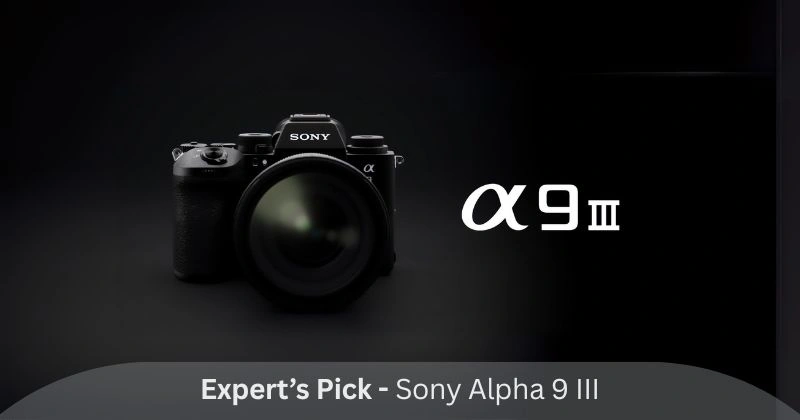
The Sony Alpha 9 III stands out as the overall best high-speed camera due to its revolutionary global shutter sensor, which eliminates rolling shutter distortion—a critical advantage for capturing high-speed action with perfect clarity.
Combined with its unparalleled 120 fps blackout-free burst shooting, advanced autofocus, and robust video capabilities, it offers an unmatched combination of speed, precision, and image integrity.
Comparison Table of Top 10 High-Speed Cameras
| Image | Name | Details | Price |
|---|---|---|---|
 | Sony Alpha 9 III |
| Check Price |
 | Canon EOS R5 Mark II |
| Check Price |
 | Nikon Z 9 |
| Check Price |
 | Fujifilm X-H2S |
| Check Price |
 | Panasonic LUMIX GH6 |
| Check Price |
 | Blackmagic Design URSA Mini Pro |
| Check Price |
 | GoPro HERO13 |
| Check Price |
 | Sony Alpha 1 |
| Check Price |
 | Nikon Z6 III |
| Check Price |
 | DJI Osmo Action 5 Pro |
| Check Price |
What to Look for When Buying a High-Speed Camera
Selecting the ideal high-speed camera requires careful consideration of several technical specifications and practical factors to ensure it meets your specific needs.
Frame Rate (FPS):
This is the most crucial specification for a high-speed camera. It dictates how many frames per second the camera can capture.
Standard video is typically recorded at 24 to 30 frames per second (fps). 120 fps for subtle slow-downs, 240 fps for noticeable slow motion, and 480 fps, 960 fps, or even thousands of fps for extreme slow-motion effects.
Resolution:
While high frame rates are key, resolution determines the detail and clarity of your slow-motion footage. High-speed shooting often requires a balance, as achieving higher frame rates means sacrificing resolution.
For example, a camera might shoot 4K at 120 frames per second (fps) but only 1080p at 240 frames per second (fps). Consider the final output format and the level of detail required for your analysis or creative vision.
Sensor Size and Type:
Larger sensors generally perform better in low light and produce cleaner images with less noise, which is vital for high-speed shooting as faster frame rates require shorter exposure times and thus more light.
Stacked CMOS sensors and Global Shutters are increasingly important in modern high-speed cameras, minimizing rolling shutter distortion (the “jello effect”) when capturing fast-moving subjects.
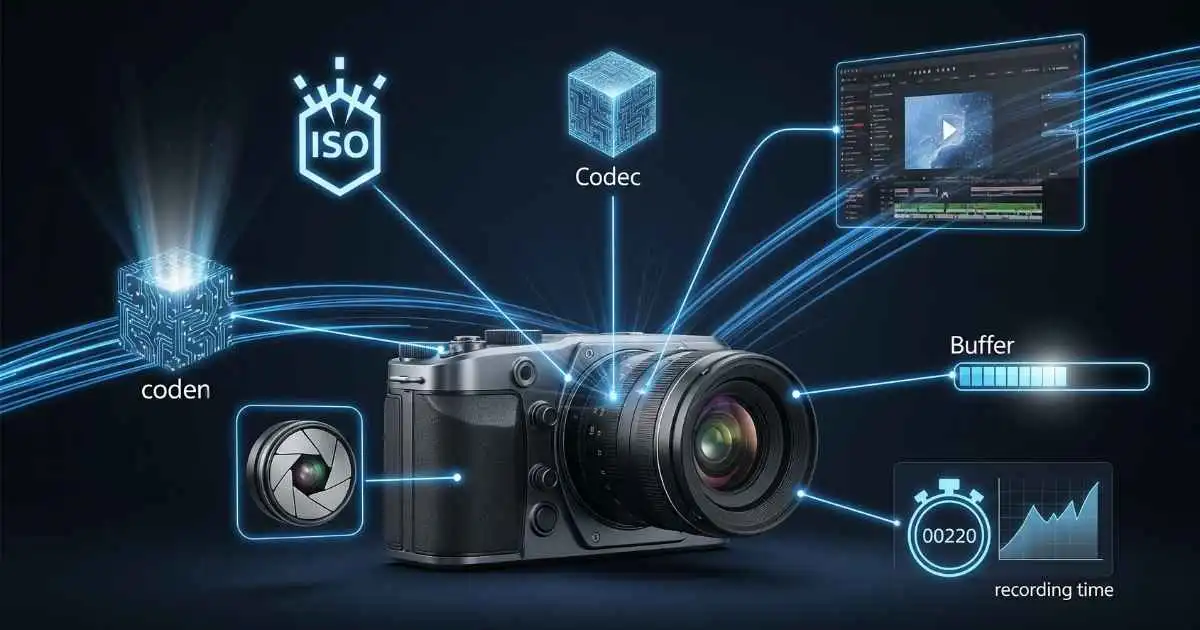
Light Sensitivity (ISO Performance):
Capturing at high frame rates demands a lot of light. High native ISO capabilities and minimal noise at elevated ISOs will allow you to shoot in more challenging lighting conditions without needing elaborate lighting setups.
Internal Recording & Codecs:
The ability to record high-frame-rate video internally to fast memory cards (like CFexpress) is crucial. RAW recording offers maximum flexibility in post-production but generates massive file sizes.
Buffer Size and Recording Time:
High-speed video generates enormous amounts of data at a rapid rate. A larger internal buffer allows the camera to record bursts for longer periods. The overall recording time will depend on the resolution, frame rate, and the speed and capacity of your memory cards.
Autofocus Performance:
For fast-moving subjects, a robust and quick autofocus system with reliable tracking is essential to keep your subject sharp even at extreme speeds. Look for advanced AF systems with subject detection and tracking capabilities.
Durability and Portability:
Depending on your intended use, the camera’s build quality, weather sealing, and size/weight become important factors. Action cameras, for instance, prioritize ruggedness and compact size.
Lens Mount & Ecosystem:
For interchangeable lens cameras, the lens mount dictates the range of compatible lenses. Consider the availability of fast lenses (wide apertures) within that ecosystem, as they are crucial for high-speed, low-light shooting.
Post-Production Workflow:
High-speed footage can be demanding on your computer and editing software. Ensure your system can handle the large file sizes and high bitrates. Features like proxy recording or efficient RAW codecs can streamline the workflow.
Budget:
High-speed cameras range from affordable action cameras to professional cinema cameras, which can cost tens of thousands of dollars. Define your budget and prioritize the features most critical for your application within that price range.
Our 10 Picks of the Best High Speed Cameras
To help you with the process of getting the best high speed camera, we have given a top 11 list of the best ones. This review is based on extensive research and consultation with buyers and experts, who provided valuable information that made this list possible.
We have not overlooked the downsides of these cameras and have included them below.
1. Sony Alpha 9 III
Best For: Professionals and enthusiasts demanding unparalleled speed, perfect motion clarity, and no rolling shutter distortion for both stills and video, especially in sports and fast-action scenarios.
Rating: 9.7/10Reason: The Sony Alpha 9 III revolutionizes high-speed capture with its groundbreaking global shutter sensor, eliminating rolling shutter effects. Its ability to shoot 120 frames per second with full AF/AE and capture 4K 120p video without crop makes it the ultimate tool for freezing fast action with absolute precision.
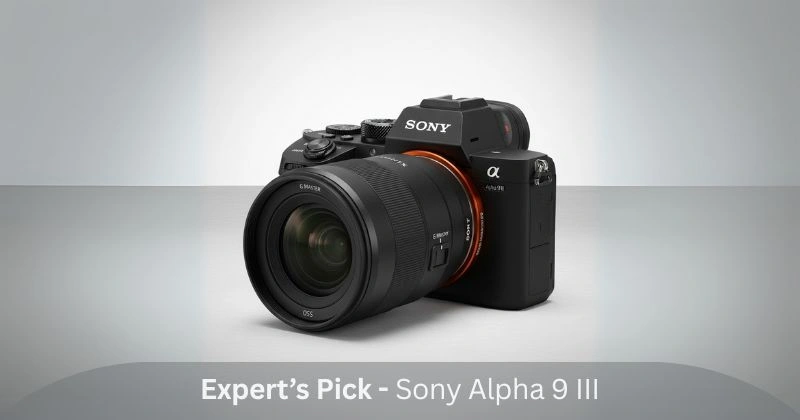
At the heart of the Sony Alpha 9 III is the world’s first full-frame global shutter image sensor, a technological leap that captures every pixel simultaneously.
This means distortion-free images of even the fastest subjects, a critical advantage for sports, wildlife, and high-speed industrial applications. It achieves an astonishing 120 frames per second continuous shooting with full AF/AE tracking and a completely blackout-free viewfinder, allowing photographers to follow action seamlessly.
Beyond its groundbreaking still capabilities, the Alpha 9 III delivers exceptional video performance, including 4K recording at up to 120 fps without any crop, enabling stunning slow-motion footage with a wide field of view.
Its advanced BIONZ XR processing engine powers a highly sophisticated autofocus system with real-time recognition of various subjects, ensuring critical sharpness. The camera also features flash synchronization at all shutter speeds and boasts a robust, professional-grade build with dual CFexpress Type A card slots for rapid data handling.
| Compatible Mountings: | Sony E |
| Aspect Ratio: | 3:2 |
| Photo Sensor: | BSI CMOS |
| Supported File Format: | HEIF, JPEG, Raw |
| Image Stabilization: | Optical |
| Optical Zoom: | 1.5 x |
| Maximum Aperture: | 4 Millimeters |
| Expanded ISO: | Minimum 125 |
| Metering Description: | Average |
| Display Size: | 3 inches |
| Lens Type: | Telephoto |
| Zoom Type: | Optical Zoom |
| Shooting Modes: | Automatic, Manual |
| Connectivity: | HDMI, Micro USB, Ethernet, Bluetooth, Wi-Fi |
| Video Resolution: | 2160p |
- World’s first full-frame global shutter sensor for zero rolling shutter distortion.
- Unmatched 120 fps continuous shooting with full AF/AE and no blackout.
- Excellent 4K 120p video recording without cropping.
- Advanced and highly accurate autofocus system with subject recognition.
- Flash synchronization at all shutter speeds up to 1/80,000 sec.
- Durable build and fast data transfer with CFexpress Type A.
- Very high price point.
- The dynamic range at base ISO may be slightly less than that of some non-global-shutter stacked sensors.
- 24.6 MP may be lower resolution for still photography compared to some hybrid cameras.
2. Canon EOS R5 Mark II Body
Best For: Hybrid shooters demanding high-resolution stills (45MP) alongside powerful 8K and high-frame-rate 4K video capabilities for diverse professional applications.
Rating: 9.3/10Reason: The Canon EOS R5 Mark II excels as a versatile high-speed camera, offering a new 45MP BSI CMOS sensor that delivers both stunning detail for stills and robust video features including 8K 60p RAW and high-frame-rate 4K 120p, making it a powerhouse for both photography and videography.
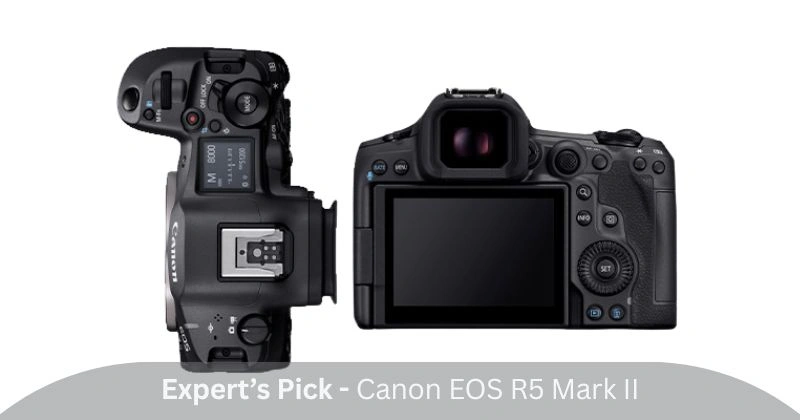
The Canon EOS R5 Mark II features a newly developed 45MP backside-illuminated (BSI) CMOS sensor, providing excellent image quality for both high-resolution stills and video. It supports impressive video recording capabilities, including 8K 60p RAW video internally and 4K recording at up to 120p, allowing for significant slow-motion effects.
Its fast sensor readout (6.3ms) significantly reduces rolling shutter distortion compared to its predecessor, making it more capable for high-speed action.
Canon’s renowned Dual Pixel CMOS AF II system is further enhanced, offering incredibly fast and accurate autofocus with advanced subject detection (including people, animals, and vehicles), ensuring sharp focus even with erratic movement. For still photography, it can achieve up to 30 fps burst shooting with the electronic shutter and full AF/AE tracking, with a deep buffer.
This camera-enhanced thermal management enables longer recording times, and its robust build quality ensures reliability in demanding professional environments.
| Compatible Mountings: | Canon RF |
| Aspect Ratio: | 16:9, 3:2, 4:3 |
| Photo Sensor: | CMOS |
| Supported File Format: | MOV |
| Image Stabilization: | Sensor-shift |
| Optical Zoom: | LCD |
| Maximum Aperture: | Macro |
| Expanded ISO: | Minimum 50 |
| Metering Description: | Center-Weighted Average, Evaluative, Partial, Spot |
| Display Size: | LCD |
| Lens Type: | Macro |
| Zoom Type: | 1.5 x |
| Shooting Modes: | Portrait, Macro, Manual, Underwater, Easy, Automatic, Movie, Custom, Shutter Priority, Landscape, Sports, Panorama |
| Connectivity: | USB, Bluetooth, Wi-Fi |
| Video Resolution: | 2160p |
- High-resolution 45MP sensor for capturing excellent detail in both still images and video.
- Impressive video capabilities, including 8K 60p RAW and 4K 120p.
- Significantly reduced rolling shutter effect compared to previous models.
- Fast 30 fps burst shooting with electronic shutter and reliable AF/AE.
- Advanced Dual Pixel CMOS AF II with improved subject detection.
- Improved thermal performance for longer recording.
- Still utilizes a rolling shutter, albeit a very fast one, so it is not entirely distortion-free, like a global shutter.
- 8K RAW generates extremely large files, requiring fast and ample storage.
- Can still experience overheating in very demanding 8K high-frame-rate scenarios.
3. Nikon Z 9
Best For: Professional photographers and videographers who need ultimate speed, robust video capabilities up to 8K, and unparalleled reliability in a mirrorless flagship body.
Rating: 9.6/10Reason: The Nikon Z 9 is a true flagship, delivering exceptional high-speed performance with its stacked CMOS sensor, which enables 20 fps RAW and 120 fps JPEG stills, alongside impressive 8K 60p and 4K 120p video. Its blackout-free EVF and advanced autofocus make it a formidable tool for capturing fast action.
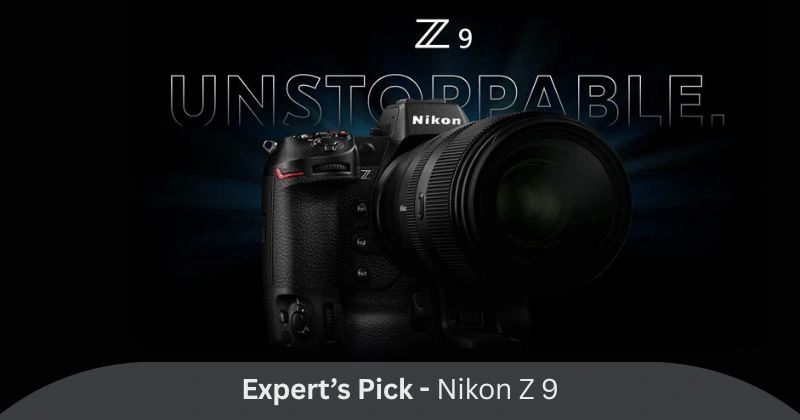
The Nikon Z 9 is built for speed and endurance. It features a 45.7MP stacked CMOS sensor and the powerful EXPEED 7 image processor, allowing for remarkable high-speed still capture: up to 20 fps in RAW with full AF/AE, an impressive 30 fps in JPEG, and an astonishing 120 fps for 11MP JPEGs, all with blackout-free viewing.
This enables photographers to capture the most fleeting moments with confidence. The stacked sensor design also significantly minimizes rolling shutter distortion, making it highly suitable for fast-moving subjects.
For video, the Z 9 is a beast, capable of internal 8K 60p video recording and 4K at up to 120p for slow-motion playback, providing incredible detail and flexibility in post-production. Its autofocus system is state-of-the-art, utilizing a deep learning-based subject detection system for precise tracking of people, animals, and vehicles.
The camera’s rugged, professional-grade build, integrated vertical grip, and dual CFexpress Type B card slots ensure reliability and rapid data handling for demanding productions.
| Compatible Mountings: | Nikon Z |
| Aspect Ratio: | 1.50:1, 16:9 |
| Photo Sensor: | CMOS |
| Supported File Format: | RAW |
| Image Stabilization: | Dual |
| Optical Zoom: | 1x |
| Expanded ISO: | 64 |
| Shooting Modes: | Auto, Programmed auto with flexible program, Shutter-priority auto, Aperature-priority auto, Manual |
| Metering Description | Evaluative |
| Display Type | LCD |
| Display Size | 3.2 inches |
| Connectivity | Ethernet, HDMI, USB, GPS, Wi-Fi, Bluetooth |
| Video Resolution | 4320p |
- Excellent 45.7MP stacked sensor for high-resolution stills and video.
- Blazing fast continuous shooting: 20 fps RAW, 30 fps JPEG, 120 fps (11MP) with full AF/AE.
- Robust video capabilities, including 8K 60p and 4K 120p.
- Blackout-free viewfinder for seamless shooting.
- Highly effective autofocus with advanced subject detection.
- Durable, professional build with an integrated grip.
- Significantly reduced rolling shutter.
- High price point for a professional flagship camera.
- Large and heavy compared to smaller mirrorless cameras.
- Battery life can be drained quickly with continuous high-speed shooting.
4. Fujifilm X-H2S
Best For: Hybrid shooters seeking a balance of high-speed stills (40fps) and advanced video features (6.2K, 4K 120p) with a stacked APS-C sensor, offering excellent performance in a more compact form factor.
Rating: 9.1/10Reason: The Fujifilm X-H2S delivers impressive high-speed capabilities for both stills and video, thanks to its new 26.1MP stacked BSI CMOS sensor. It’s 40 fps burst shooting, 6.2K 30p, and 4K 120p video recording with low rolling shutter, making it a versatile tool for capturing fast-moving subjects.
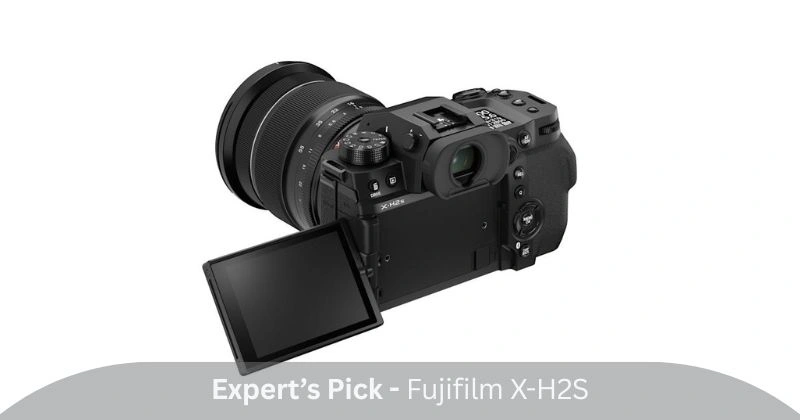
The Fujifilm X-H2S is built around a new 26.1MP X-Trans CMOS 5 HS (stacked BSI) sensor, which enables incredibly fast readout speeds. This translates to exceptional high-speed still photography, with the ability to shoot blackout-free bursts at up to 40 frames per second (electronic shutter) with full AF/AE tracking.
The stacked sensor design also minimizes rolling shutter distortion, making it excellent for dynamic subjects.
For videographers, the X-H2S is a powerhouse, offering internal 6.2K 30p recording, and high-speed 4K 120p for significant slow-motion effects, along with Full HD at 240p. It supports professional codecs like Apple ProRes internally, and features improved thermal management for extended recording times. The camera’s autofocus system has been significantly enhanced with deep learning technology, providing reliable subject detection and tracking for a wide range of subjects.
| Compatible Mountings: | Fujifilm X |
| Aspect Ratio: | 1.50:1, 16:9 |
| Photo Sensor: | CMOS |
| Supported File Format: | JPEG, RAW, TIFF |
| Image Stabilization: | Sensor-shift |
| Optical Zoom: | 1x |
| Maximum Aperture: | 3.5 Millimeters |
| Expanded ISO: | 80 |
| Metering Description: | Center Weighted |
| Resolution | 26.1 megapixel |
| Monitor | 3.0 inch vari-angle Touch Screen Color LCD Monitor |
| Connectivity | Bluetooth, Wi-Fi, USB-C, HDMI micro Type D, 3.5mm microphone, 2.5mm remote, flash sync and hot shoe |
| Weight | 660g |
- Fast 40 fps blackout-free burst shooting with electronic shutter.
- Strong video capabilities: 6.2K 30p, 4K 120p, Full HD 240p.
- Minimizes rolling shutter due to the stacked sensor.
- Improved autofocus with subject detection.
- Internal Apple ProRes recording and good thermal performance.
- More compact and lighter than full-frame flagships.
- APS-C sensor, which may have slightly lower low-light performance than full-frame rivals.
- Battery life, although good, may be a consideration for users with heavy and high-speed usage.
5. Panasonic LUMIX GH6
Best For: Videographers and filmmakers prioritizing extensive video recording capabilities, especially high frame rates in 4K and 5.7K, with a Micro Four Thirds sensor for versatility and stabilization.
Rating: 8.8/10Reason: The Panasonic LUMIX GH6 is a video-centric powerhouse, offering impressive high-frame-rate recording options including 5.7K 60p and 4K 120p, along with robust internal recording codecs. Its strong in-body image stabilization and active cooling system make it ideal for demanding video productions.
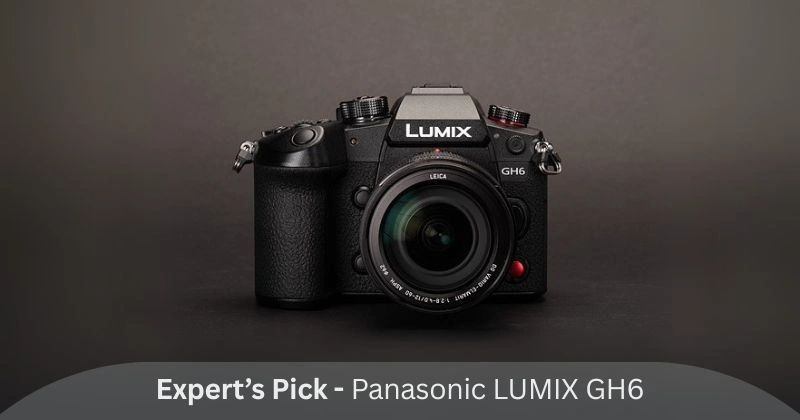
The Panasonic LUMIX GH6 pushes the boundaries for Micro Four Thirds video cameras. It features a new 25.2MP Live MOS sensor and Venus Engine, enabling a wide array of high-resolution and high-frame-rate video recording options. It can capture 5.7K video at up to 60p and offers 4K video at up to 120p for significant slow-motion effects, alongside Full HD at an impressive 240p.
These capabilities allow for highly detailed and smooth slow-motion capture.
A key strength of the GH6 is its professional-grade internal recording capabilities, which support Apple ProRes 422 HQ and ProRes 422 formats, allowing for CFexpress Type B cards and providing excellent post-production flexibility. It boasts a powerful 5-axis in-body image stabilisation (IBIS) system, offering up to 7.5 stops of compensation, which is crucial for handheld high-speed shooting.
The camera also features an active cooling system, enabling extended recording times without overheating, a vital feature for high-resolution, high-frame-rate video.
| Compatible Mountings: | Micro Four Thirds |
| Aspect Ratio: | 1.50:1, 16:9, 4:3 |
| Display: | LCD, 3 inches |
| Lens Type: | Wide Angle |
| Zoom Type: | Optical Zoom |
| Connectivity: | HDMI, USB, Wi-Fi, Bluetooth |
| Photo Sensor: | MOS |
| Supported File Format: | MOV |
| Image Stabilization: | Sensor-shift, Dual |
| Video Resolution: | 2160p |
| Shooting Modes: | Bulb Mode, Time Mode,Aperture Priority, Manual, Program, Shutter Priority |
| Maximum Focal Length: | 140 Millimeters |
| Maximum Aperture: | 3.5 Millimeters |
| Expanded ISO Minimum: | 100 |
| Metering Description: | Center-Weighted Average, Highlight Weighted, Multiple, Spot |
- Extensive high-frame-rate video options: 5.7K 60p, 4K 120p, Full HD 240p.
- Internal Apple ProRes recording to CFexpress cards.
- Class-leading 7.5-stop in-body image stabilization (IBIS).
- Active cooling system for extended recording times.
- Robust build and flexible connectivity options.
- Micro Four Thirds sensor is smaller than APS-C or full-frame, potentially affecting low-light performance.
- Autofocus system, while improved, may not be as robust as some phase-detect systems from Sony or Canon.
- Not primarily a still photography camera compared to hybrid rivals.
6. Blackmagic Design URSA Mini Pro 12K
Best For: High-end cinematic productions requiring extreme resolution (12K) and high frame rates for unparalleled flexibility in reframing, VFX, and ultra-detailed slow motion.
Rating: 9.5/10Reason: The Blackmagic Design URSA Mini Pro 12K is a revolutionary cinema camera that redefines high-speed, high-resolution video. Its ability to capture 12K at 60fps, 8K at 120fps, and 4K at 240fps, all in Blackmagic RAW, offers filmmakers unprecedented detail and creative freedom.
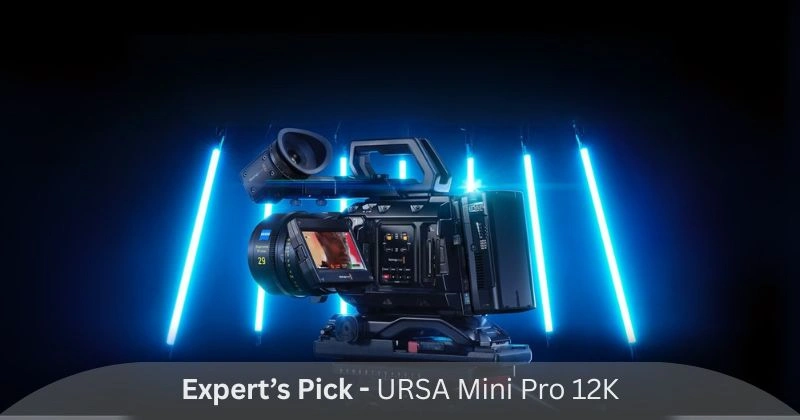
The Blackmagic Design URSA Mini Pro 12K features a unique 12,288 x 6480 12K Super 35 sensor, making it capable of capturing an astounding 80 megapixels per frame. This massive resolution allows for extreme flexibility in post-production, enabling reframing, cropping, and oversampling for incredibly detailed 8K and 4K deliverables.
Crucially, for high-speed capture, it can shoot 12K at 60 fps, 8K at 120 fps, and even 4K at an incredible 240 fps (in Super 16 crop mode), all in Blackmagic RAW.
The camera’s integration with Blackmagic RAW optimizes the workflow for such high-resolution, high-frame-rate footage, making it manageable to edit and color grade. It boasts 14 stops of dynamic range, providing rich tonal information, and supports recording to dual CFast cards or an external USB-C drive for robust data management.
The URSA Mini Pro body is designed for professional cinema production, featuring built-in ND filters, interchangeable lens mounts (including PL), and comprehensive connectivity.
| Photo Sensor: | CMOS |
| Video Resolution: | 12 |
| Flash Memory Type: | SD |
| Video Capture Format: | Blackmagic RAW, ProRes, DNxHD |
| Supported Audio Format: | AAC, PCM |
| Screen Size: | 4 Inches |
| Optical Zoom: | 3x |
| Connectivity: | USB |
| Color: | Black |
| Special Feature: | Infrared, Night Vision, Anti-Shake, Time Lapse |
| Form Factor: | Compact |
| Image Stabilization: | Dynamic |
| Exposure Control Type: | Manual |
- Revolutionary 12K sensor for extreme resolution and reframing flexibility.
- Exceptional high frame rates: 12K 60p, 8K 120p, 4K 240p.
- Records in highly efficient Blackmagic RAW for manageable post-production.
- Excellent 14-stop dynamic range for cinematic quality.
- A professional cinema camera built with comprehensive features.
- Oversampling from 12K results in incredibly sharp 8K/4K footage.
- An extremely high price point, targeting professional productions.
- Large and heavy, requiring a robust rig setup.
- Not designed for still photography; primarily a video camera.
- Requires powerful computers for 12K RAW editing.
7. GoPro HERO13 Black
Best for: Action sports enthusiasts, vloggers, and adventurers who need extremely durable, portable cameras with high-frame-rate capabilities for capturing immersive slow-motion action shots.
Rating: 8.5/10Reason: The GoPro HERO13 Black is a compact powerhouse for capturing action, offering excellent high-frame-rate options like 5.3K 120p, 4K 240p, and even 720p 400fps for extreme slow motion, combined with industry-leading stabilization in a rugged, waterproof design.
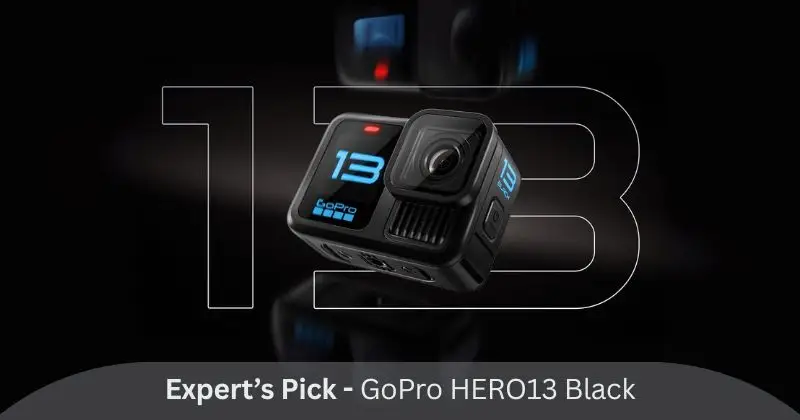
The GoPro HERO13 Black is designed to capture breathtaking action from unique perspectives. It features a new, larger image sensor, allowing for a taller 8:7 aspect ratio, which provides more vertical room for reframing. Critically, for high-speed recording, it can capture 5.3K video at up to 120 frames per second, delivering stunning detail even when played back at a slower frame rate.
For even more dramatic slow motion, it offers 4K at 240 fps and Full HD 1080p at an incredible 480 fps.
GoPro’s renowned HyperSmooth 6.0 video stabilization ensures incredibly smooth footage, even during the most intense activities, which is vital for high-speed content. The camera is inherently rugged and waterproof up to 33ft (10m) without a housing, making it ideal for extreme sports and underwater adventures.
It features a durable, water-repellent lens cover, dual LCD screens, and enhanced audio capabilities, providing a comprehensive action camera experience.
| Photo Sensor: | CMOS |
| Video Capture Resolution: | 5.3K |
| Maximum Focal Length: | 35 Millimeters |
| Maximum Aperture: | 2 f |
| Flash Memory Type: | Micro SD |
| Form Factor: | Handheld |
| Exposure Control Type: | Automatic |
| Lens Type: | Wide Angle |
| Image Stabilization: | Hybrid |
| Video Capture Format: | MP4 |
| Shooting Modes: | Automatic, High Resolution, Action, Landscape, Night, Underwater |
| Supported Audio Format: | Some common audio formats |
| Connectivity: | USB |
| Color: | Black |
| Item Weight: | 5.5 ounces |
- Extremely compact, rugged, and waterproof, without the need for a housing.
- Excellent high-frame-rate options: 5.3K 120p, 4K 240p, 1080p 480fps.
- Industry-leading HyperSmooth 6.0 video stabilization.
- New, larger sensor with an 8:7 aspect ratio for reframing flexibility.
- Intuitive user interface and versatile mounting options.
- “Burst Slo-Mo” feature for extremely high frame rates at lower resolutions.
- A smaller sensor compared to mirrorless cameras affects low-light performance.
- Fixed lens (no interchangeable lenses).
- Battery life can be a limitation when recording at a continuous high frame rate.
- Rolling shutter can be noticeable at lower frame rates, though minimized at higher ones.
8. Sony Alpha 1 Full-frame Interchangeable Lens Mirrorless Camera
Best For: Professional sports and wildlife photographers, and filmmakers who demand the absolute pinnacle of speed, resolution (50.1MP), and advanced video capabilities in a single, uncompromised full-frame body.
Rating: 9.8/10Reason: The Sony Alpha 1 is a true flagship “alpha” camera, masterfully blending a high-resolution 50.1MP sensor with blazing speed. It’s 30 fps blackout-free still shooting, 8K 30p, and 4K 120p video, combined with a stacked sensor and advanced AF, make it arguably the most versatile high-speed camera for professionals.

The Sony Alpha 1 is engineered to be the ultimate hybrid camera, offering an unprecedented blend of speed and resolution. It features a 50.1MP full-frame stacked Exmor RS CMOS sensor and the powerful BIONZ XR processing engine, enabling an astonishing 30 frames per second continuous shooting with full AF/AE tracking and a completely blackout-free view via the electronic viewfinder.
The stacked sensor design also dramatically minimizes rolling shutter distortion, even when capturing ultra-fast subjects.
For video, the Alpha 1 is equally impressive, capable of internal 8K 30p recording for incredible detail, and 4K recording at up to 120p for significant slow-motion effects. It supports 10-bit 4:2:2 recording and S-Cinetone for cinematic color. Sony’s Real-time Tracking and Real-time Eye AF are further refined, offering incredibly fast and accurate autofocus for people, animals (including birds), and even vehicles.
Its robust build, dual CFexpress Type A/SD card slots, and extensive connectivity options solidify its position as a professional powerhouse.
| Compatible Mountings: | Sony E |
| Aspect Ratio: | 1.50:1, 16:9, 4:3 |
| Photo Sensor: | CMOS |
| Supported File Format: | HEIF, JPEG, Raw |
| Image Stabilization: | Sensor-shift |
| Maximum Focal Length: | 24 Millimeters |
| Zoom: | 1x Optical |
| Maximum Aperture: | 2.8 f |
| Expanded ISO: | Minimum 50 |
| Display Type: | LCD |
| Display Size: | 3 inches |
| Lens Type: | Prime |
| Connectivity Tech: | HDMI, Micro USB, NFC, Bluetooth, Wi-Fi |
| Shooting Modes: | AUTO, Programmed AE, Aperture priorty, Shutter-speed priority, Manual, Movie, Slow and Quick Motion |
| Video Resolution: | 4320p |
| Metering Description: | Center-Weighted Average, Highlight Weighted, Multiple, Spot |
- Unrivalled combination of 50.1MP resolution and 30 fps blackout-free shooting.
- Excellent video capabilities: 8K 30p and 4K 120p.
- Stacked sensor design significantly reduces rolling shutter distortion.
- Advanced Real-time Tracking and Eye AF for unparalleled subject tracking.
- Robust professional-grade build and excellent handling.
- Dual CFexpress Type A and SD card slots for a fast workflow.
- Extremely high price, placing it firmly in the professional flagship category.
- Can generate very large files, requiring powerful post-production systems.
- While minimal, still technically a rolling shutter sensor, not a global shutter.
9. Nikon Z6 III | Full-Frame mirrorless Still & Video Camera
Best For: Enthusiast and professional hybrid shooters seeking excellent video and still capabilities, including 6K RAW video and 4K 120p slow motion, with an innovative partially-stacked sensor and a bright EVF.
Rating: 9.0/10Reason: The Nikon Z6 III offers flagship-level features at a more accessible price point, including 6K 60p internal RAW video and 4K 120p slow motion, powered by a new partially stacked sensor. Its advanced autofocus and bright EVF make it a compelling choice for creators needing high-speed capabilities.
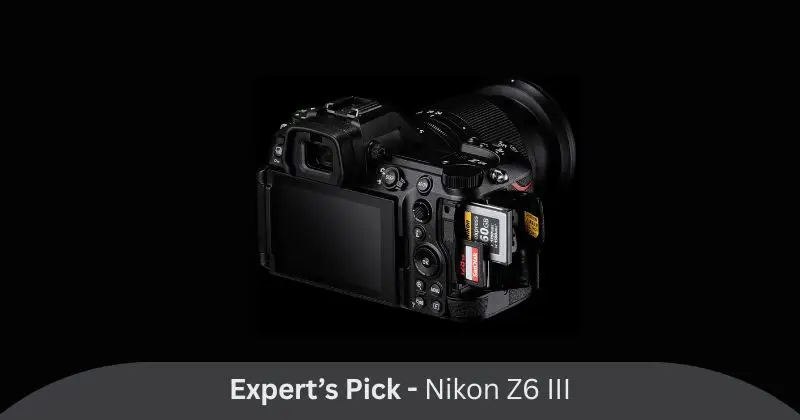
The Nikon Z6 III features an innovative, partially stacked 24.5MP full-frame CMOS sensor, which enables significant speed improvements while maintaining excellent image quality. This allows for impressive still photography burst rates, including 120 fps for 11MP stills with Pre-Release Capture, and up to 60 fps for 24MP stills, ensuring you don’t miss crucial moments.
The partially-stacked design also helps to minimize rolling shutter distortion, improving performance for fast-moving subjects.
For video, the Z6 III is highly capable, offering internal 6K 60p N-RAW and ProRes RAW recording, as well as 4K video at up to 120p for smooth slow motion. It also supports Full HD at 240p. Nikon’s advanced autofocus system, inherited from the Z9, provides reliable subject detection and tracking.
The camera boasts the world’s brightest electronic viewfinder (EVF), providing a clear and detailed view even in challenging lighting conditions, thereby enhancing the high-speed shooting experience.
| Compatible Mountings: | Nikon Z |
| Aspect Ratio: | Unknown |
| Photo Sensor: | CMOS |
| Supported File Format: | JPEG |
| Image Stabilization: | Sensor-shift |
| Zoom: | 1x Optical |
| Expanded ISO: | Minimum 100 |
| Display Type: | LCD |
| Display Size: | 3.2 inches |
| Connectivity Tech: | Wi-Fi, Bluetooth, USB, HDMI |
| Video Resolution: | 3024p |
| Shooting Modes: | Automatic |
| Metering Description: | Evaluative |
- Internal 6K 60p N-RAW and ProRes RAW video recording.
- Excellent high-frame-rate options: 4K at 120p and Full HD at 240p.
- Innovative partially-stacked sensor for speed and reduced rolling shutter.
- Blazing fast still burst rates, including 120 fps (11MP) with Pre-Release Capture.
- Bright and high-resolution EVF for clear viewing.
- Advanced autofocus with subject detection.
- A partially stacked sensor, while fast, is not a full global shutter.
- Battery life can be a concern when recording continuously at high resolution and high frame rates.
- Still video-focused, though stills are very capable.
10. DJI Osmo Action 5 Pro Standard Combo
Best For: Everyday adventurers, vloggers, and content creators needing a compact, durable, and highly portable camera with strong high-frame-rate capabilities for creative slow-motion video.
Rating: 8.3/10Reason: The DJI Osmo Action 5 Pro is an excellent action camera offering impressive high frame rates for its size, including 4K 120p and 1080p 240fps, along with superior stabilization and a rugged, waterproof design, making it ideal for capturing dynamic slow-motion footage in any environment.
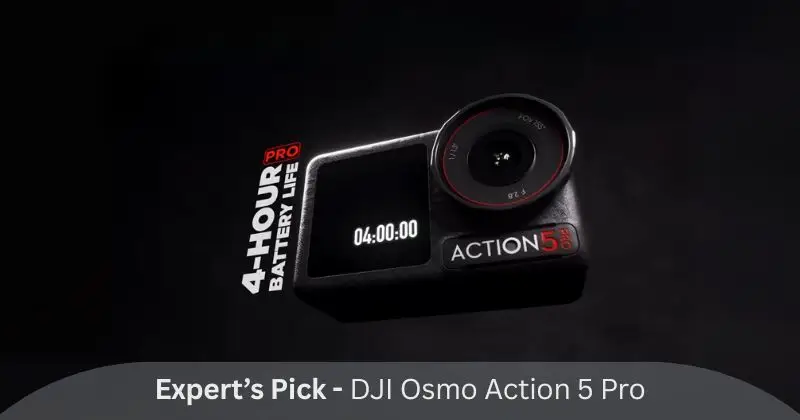
The DJI Osmo Action 5 Pro is designed to capture life’s adventures with vivid detail and smooth action. It features an upgraded 1/1.3-inch CMOS sensor which delivers enhanced low-light performance and dynamic range, crucial for maintaining image quality in various shooting conditions.
For high-speed video, it excels with capabilities such as 4K recording at 120 frames per second for cinematic slow motion, and Full HD 1080p at up to 240 frames per second for super slow-motion effects.
Its proprietary RockSteady 3.0+ and HorizonSteady stabilization ensure your footage remains incredibly smooth and level, even during intense activities. The camera is built to be rugged, being waterproof up to 20 meters (60m with case) without additional housing, and resistant to extreme temperatures.
With dual high-brightness OLED touchscreens, extended battery life of up to 4 hours, and quick file transfer via Wi-Fi 6, the Osmo Action 5 Pro offers a seamless and versatile shooting experience.
| Photo Sensor: | CMOS |
| Video Capture Resolution: | 4K |
| Maximum Focal Length: | 24 Millimeters |
| Maximum Aperture: | 2.8 f |
| Flash Memory Type: | Micro SD |
| Video Capture Format: | MP4 |
| Supported Audio Format: | 48 kHz 16-bit; AAC |
| Screen Size: | 2.5 Inches |
| Form Factor: | Compact |
| Display Size: | 2.5 inches |
| Video Resolution: | 4K |
| Shooting Modes: | Low Light, Sports |
| Lens Type: | Zoom |
| Connectivity: | Bluetooth, Wi-Fi |
- Excellent high-frame-rate options: 4K 120p, 1080p 240fps.
- Superior RockSteady and HorizonSteady image stabilization.
- Rugged, waterproof design for extreme environments.
- Upgraded 1/1.3-inch sensor for improved low-light performance and dynamic range.
- Dual high-brightness OLED touchscreens.
- Long battery life for an action camera.
- Fixed lens (no interchangeable lenses).
- Smaller sensor compared to mirrorless cameras, still limiting ultimate low-light performance.
- Not suitable for professional cinema productions that require extensive controls or high-resolution RAW capabilities.
- A rolling shutter is present, although it is generally well-controlled.
Things to Consider When Buying Best High Speed Camera
When it comes to high-speed cameras, there are a few key factors to consider to ensure your purchase is worthwhile. If you are a beginner learning photography, you don’t need many of the features that professionals typically require.
If you are a professional and looking to upgrade, you probably already know what features you want. However, before purchasing the best high-speed camera, you can visit the Wikipedia page or refer to the information we provide, which will help you identify a high-quality camera.
Photography vs. Video Making
There is a significant difference between cameras designed for photography and those designed for videography. Each requires special features tailored to its respective field.
Cameras for photography require high resolution. The unit of resolution is pixels. Pixels refer to small dots of colour in a picture. More dots mean a more detailed picture.
Cameras for videography need a higher frame rate. We measure frame rate by FPS. FPS stands for frames per Second. A high frame rate camera produces clearer video and is ideal for slow-motion videography.
ISO
Now, ISO can be a complex concept to understand initially. Basically, ISO refers to the sensitivity of light. A higher ISO rate isn’t always good. When the camera is too sensitive to light, you might get distortion in the image.
However, a higher ISO rate is beneficial when taking pictures in low-light conditions. Nowadays, cameras include special features that make them highly sensitive to light while maintaining a high ISO.
Shutter Speed
Shutter speed is an important aspect of a digital camera. It decides how much light will go through your camera’s lens. When the camera has a high-speed shutter that opens and closes very quickly, the image will remain still, allowing you to capture anything that’s in fast motion.
When the shutter speed is slow, it creates a blurry picture when capturing something that is in motion.
To get a clear picture, it’s best to purchase cameras with a high shutter speed. It is also a key feature of a high-speed camera.
Aperture
In cameras, “Aperture” refers to the hole through which light travels. It is also a key element of a camera, and it makes a great difference.
There are large, medium, and small apertures. A larger aperture allows more light to pass through the lens, thereby increasing the brightness. In a dark environment, a large aperture is the best choice.
Small apertures reduce the amount of light entering the lens and, consequently, decrease the brightness.
Buying Guide: Choosing Your High-Speed Camera
Selecting the best high-speed camera depends heavily on your specific application and priorities. Here’s a breakdown by common use cases:
For Professionals Demanding Unparalleled Speed & Precision (Sports, Wildlife, Photojournalism):
If your primary goal is to capture the absolute peak of action without compromising image integrity or speed, the Sony Alpha 9 III is your top choice. Its global shutter eliminates rolling shutter and its 120 fps continuous shooting is unmatched. The Sony Alpha 1 and Nikon Z 9 are also exceptional contenders.
Also offering incredibly high frame rates for stills (30 fps for Alpha 1, 20/30/120 fps for Z 9) with robust video capabilities and highly minimized rolling shutter. Making them ideal for professionals who require both high-resolution still images and powerful video capabilities.
For Filmmakers & Videographers (Cinematic Slow Motion, VFX):
Suppose high-quality, high-frame-rate video for cinematic productions is your focus. In that case, the Blackmagic Design URSA Mini Pro 12K stands out with its extreme resolution and incredible high-frame-rate RAW capabilities (up to 4K 240p). For hybrid filmmakers seeking both stills and video, the Canon EOS R5 Mark II offers 8K 60p RAW and 4K 120p with a 45MP sensor.
The Fujifilm X-H2S offers 6.2K and 4K 120p video in a compact APS-C form factor. The Panasonic LUMIX GH6 is a strong contender for video-centric users on a tighter budget who still need professional codecs and high frame rates (4K 120p, 5.7K 60p).
For Action & Adventure Content Creators (Vlogging, Sports, Travel):
For ruggedness, portability, and excellent slow-motion capabilities in challenging environments, the GoPro HERO13 Black and DJI Osmo Action 5 Pro are ideal. They offer 4K 120p and even higher frame rates at lower resolutions, along with excellent built-in stabilization, making them perfect for capturing dynamic, immersive action shots.
For Hybrid Creators on a Budget (Advanced Enthusiasts, Smaller Productions):
The Nikon Z6 III offers a compelling package with its partially stacked sensor, 6K internal RAW, and 4K 120p capabilities, making it a fantastic value for advanced enthusiasts and professionals who require strong performance across both stills and video without the flagship price tag.
The Fujifilm X-H2S also fits this category, offering a similar hybrid appeal with its stacked APS-C sensor.
Frequently Asked Questions
What is the main difference between a “high-speed camera” and a regular camera with slow-motion mode?
High-speed cameras offer significantly higher sustained frame rates at higher resolutions with less distortion due to specialized sensors and processing, unlike regular cameras that provide limited slow-motion at lower quality.
What is “rolling shutter” and why is it bad for high-speed video?
Rolling shutter causes image distortion in fast-moving scenes because the sensor reads the image in parts, which is detrimental for high-speed video where subjects move very quickly.
How much light do I need for high-speed shooting?
A lot; high frame rates require very fast shutter speeds, necessitating bright, continuous lighting and cameras with excellent low-light performance.
What kind of memory card do I need for high-speed cameras?
You need very fast memory cards, such as CFexpress Type A or B, to handle the massive data rates of high-resolution, high-frame-rate footage.
Can these cameras record sound when shooting high-speed video?
No, most cameras do not record audio at very high frame rates, as the focus is on visual motion analysis and slowed-down audio would be distorted.
Wrapping Up
Different types of cameras have different uses and specifications, which should be known before purchasing. While photography is an art form that has been around for a long time, cameras continue to improve daily. New features are being added every day, and it’s better to be up-to-date with them.
We hope that our comprehensive review can help you find the perfect camera, whether you are buying for the first time or a professional photographer looking for an upgrade.
What to Read Next:
- Best Low Light Point and Shoot Camera 2025 – Top 10 Picks
- 10 Best High Speed Camera Review and Complete Guide
- 10 Best Low Light Mirrorless Camera – Review and Buying Guide
- 10 Best LED Whips in 2025 – Review and Complete Guide
- 6 Best Batteries for Trail Cameras – Review and Complete Guide
- 10 Best Camera For Night Sky Photography Review and Complete Guide
- Best Cellular Trail Cameras In 2025: Reviews and Buying Guide










Leave a Reply